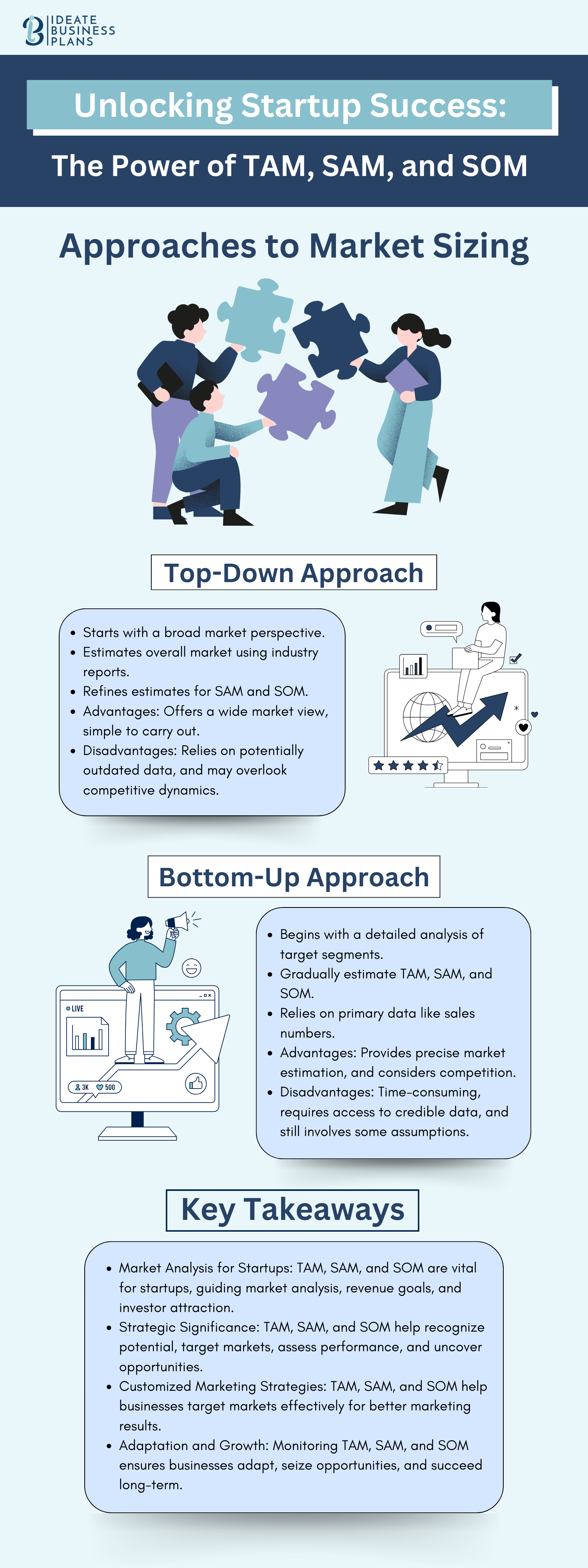Beginning an entrepreneurial journey necessitates a thorough awareness of the business landscape in addition to a ground-breaking idea. Success in the startup world depends not just on creativity but also on strategic market analysis. The three criteria that are necessary to unleash market potential are TAM, SAM, and SOM. These indicators become vital guides that help entrepreneurs navigate the complex web of market variables as they create their pitch decks and compete for investors’ attention. Come along as we explore the worlds of TAM, SAM, and SOM, revealing their meaning and shedding light on the route to startup success.
The terms Total Addressable Market (TAM), Serviceable Addressable Market (SAM), and Serviceable Obtainable Market (SOM) stand for three key criteria that characterize the state of the market. While SAM limits the market to the fraction that is achievable, TAM represents the whole potential market size that a startup may achieve. This is further refined by SOM, which takes into consideration the possible share of the SAM that a company can get. TAM provides investors with a broad overview of the market potential, SAM identifies certain target markets, and SOM defines revenue that may be earned. These three indicators offer a strategic road map that helps businesses define their market space, pinpoint their target market, and project their income streams—all critical components that draw in venture capital (VC) funding.

Navigating Market Metrics: TAM, SAM, and SOM Simplified
TAM (Total Addressable Market)
Total Addressable Market, or TAM, is the foundation for understanding a product or service’s prospective market. TAM is the total aggregate demand (TAM) for a business’s offerings in a certain market. Think of it as the maximum revenue a company could potentially generate by selling to every possible customer in that market. TAM is an essential measure for entrepreneurs creating their pitch decks since it gives them a broad overview of the market and helps them set revenue goals that are both challenging and achievable.
Calculating TAM: Understanding Market Potential
The term “Total Addressable Market” (TAM) refers to the highest possible income that a company may make inside a certain market by offering its goods or services. TAM, which is determined by multiplying the maximum product price by the number of prospective customers, offers a critical perspective on the market’s financial worth or clientele. Though it seems straightforward, TAM computation frequently involves intricate assumptions on market size and development paths. It becomes essential to do in-depth market research to make sure these presumptions match reality. TAM is a fundamental statistic used in business planning that provides investors with an overview of a company’s growth possibilities and directs the development of intricate business plans.
SAM (Serviceable Addressable Market)
The focus is narrowed by the Serviceable Addressable Market (SAM), which goes beyond the broad reach of TAM. Focusing on the segment of the market that corresponds with a startup’s product or service offering, SAM is a subset of TAM. In essence, SAM pinpoints the traits and demographics of the market niche that a company might successfully fill. Understanding SAM is critical for businesses as it helps them define their target markets, improve their marketing tactics, and set attainable growth goals—all of which are necessary components of a strong pitch deck.
Calculating SAM: Navigating Targeted Market Segments
The percentage of the market that your company can reasonably service is known as the serviceable available market, or SAM. Multiply the maximum product price by the TAM of your chosen category to get SAM. SAM is dependent on a variety of variables, including the number of prospective clients, the routes of distribution, and the geographic scope. Startups need to understand SAM well since it indicates the highest income potential that can be attained in particular market niches.
SOM (Serviceable Obtainable Market)
Serviceable Obtainable Market (SOM) is relevant to entrepreneurs who want to convert market potential into real income. SOM offers a practical evaluation of the share of SAM that a company may reasonably hope to acquire in a specified amount of time, usually three to five years. Several variables, including competition, pricing strategies, marketing approaches, and operational capabilities, must be taken into account while calculating SOM. SOM provides a clear road to sustained success, helps with strategic planning, and provides a view into short-term growth possibilities for entrepreneurs pitching to venture capitalists (VCs).
Calculating SOM: Setting Short-Term Goals
The concept of Serviceable Obtainable Market (SOM) explores the usefulness of capturing market share. Businesses can estimate SOM by multiplying the income from the prior year by the SAM for the current year. This indicator aids in determining the realistic market share that may be attained with existing methods and in defining short-term business ambitions. SOM is an essential instrument for directing firms toward attainable revenue targets, particularly in the cutthroat world of venture capital funding applicants.
Approaches to Market Sizing
Top-Down Approach
This approach begins with a broad market perspective before focusing on specific target categories. It estimates the overall market using industry reports and research data, then refines it for SAM and SOM.
Advantages:
- Gives a wide view of the market
- Fast and simple to carry out
- Helpful for an initial assessment of the market
Disadvantages:
- Depends on secondary data that can be outdated
- Could ignore competitive dynamics and market details
- This might cause the market size to be overestimated
Bottom-Up Approach
starts with a thorough examination of the target segments and works its way up to an estimation of TAM, SAM, and SOM. For a more accurate estimate, it compiles primary data such as sales numbers and survey results.
Advantages:
- Provides a more precise estimation of the market size
- Takes competition and market dynamics into account
- Capable of establishing reasonable goals
Disadvantages:
- Time and resource-consuming
- Requires having access to credible primary data
- Still requires some approximations and assumptions
The Significance of TAM, SAM, and SOM in Business Strategy
Recognizing the Potential and Size of the Market
The market size and potential of a product or service may be greatly estimated using TAM, SAM, and SOM. Businesses may better understand the market opportunity, prospective client base, and entry hurdles by examining each market category. Consider releasing a brand-new mobile game application, for example. You can determine the market’s overall demand for gaming applications by calculating the TAM. The subset of potential users most likely to interact with your app may be identified with the use of SAM analysis. Finally, the SOM assessment shows you the percentage of consumers you can reach in a certain amount of time. Equipped with this knowledge, customized marketing tactics may successfully connect with target consumers, gaining a piece of the market.
Identifying Target Market and Segmentation
The target market and segmentation are identified using TAM, SAM, and SOM, which is essential for creating customized marketing strategies. Businesses may identify profitable consumer categories and adjust marketing messaging by analyzing SAM and SOM. Consider starting a line of environmentally friendly home goods, for example. Two major consumer categories may emerge from SAM and SOM analysis: customers who prioritize cost and those who are environmentally sensitive and looking for sustainable options. Equipped with this understanding, marketing campaigns may be adapted to emphasize affordability for one group and environmental friendliness for another.
Assessing Market Performance and Potential
The metrics TAM, SAM, and SOM make it easier to assess market potential and performance over time. It is possible to spot patterns and improve strategies by keeping track of changes in these indicators. Businesses could need to change direction or focus on a new market sector, for instance, if TAM indicates a contracting market. Likewise, companies may improve their marketing strategies by keeping an eye on performance indicators like market share and client acquisition cost. Imagine a situation where a software provider of project management tools targets small and medium-sized enterprises (SAM and SOM analysis). This focused strategy maximizes ROI and resource utilization.
Identifying New Market Opportunities
Through the discovery of neighboring markets or segments, TAM, SAM, and SOM assist in the identification of new market prospects. An organization that specializes in healthy snacks, for example, may discover a corresponding demand for organic drinks. The business may develop and grow its product range to satisfy customers who are concerned about the environment by utilizing its current skills. This improves the chances for corporate growth by expanding the product portfolio and breaking into a new market.
Conclusion
In conclusion, firms need to use TAM, SAM, and SOM to comprehend and manage the market. They aid in determining the market’s size, the identities of potential clients, and the most efficient ways to connect with them. Businesses may use these indicators to monitor their progress over time, set realistic targets, and customize their strategy for various client groups. In the cutthroat world of business, entrepreneurs may boost their prospects of long-term success by making better decisions with TAM, SAM, and SOM.
It is essential to have a thorough awareness of market dynamics in the fast-paced corporate world of today. The useful insights offered by TAM, SAM, and SOM enable firms to flourish in the face of shifting circumstances and adapt. By utilizing these measures, businesses may find new possibilities, improve their strategies, and remain ahead of the curve. TAM, SAM, and SOM are essentially compasses that direct companies toward expansion and success in a constantly changing market.


